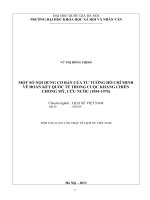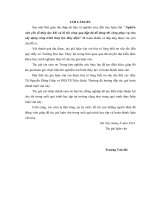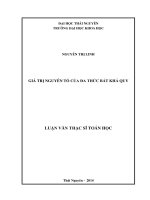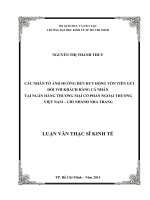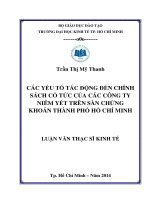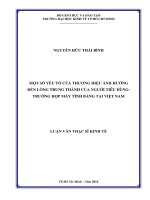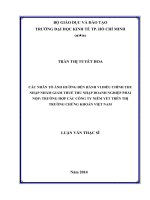(Luận văn thạc sĩ) factors affecting intention to invest in gold evidence from ho chi minh city , vietnam
Bạn đang xem bản rút gọn của tài liệu. Xem và tải ngay bản đầy đủ của tài liệu tại đây (1.12 MB, 73 trang )
UNIVERSITY OF ECONOMICS HO CHI MINH CITY
International School of Business
----------
Truong Trung Tai
FACTORS AFFECTING INTENTION TO INVEST IN GOLD:
EVIDENCE FROM HO CHI MINH CITY, VIETNAM
MASTER OF BUSINESS
Ho Chi Minh City – Year 2016
UNIVERSITY OF ECONOMICS HO CHI MINH CITY
International School of Business
-----------
Truong Trung Tai
FACTORS AFFECTING INTENTION TO INVEST IN GOLD:
EVIDENCE FROM HO CHI MINH CITY, VIETNAM
ID: 60340102
MASTER OF BUSINESS
SUPERVISOR: DR. PHAM PHU QUOC
Ho Chi Minh City – Year 2016
3
Master Thesis
FACTORS AFFECTING INTENTION TO INVEST IN GOLD:
EVIDENCE FROM HO CHI MINH CITY, VIETNAM
Truong Trung Tai
University of Economics HCMC
International School of Business
4
Table of Contents
Acknowledgement ......................................................................................................................... 7
Abstract.......................................................................................................................................... 8
Chapter 1: Introduction ............................................................................................................... 9
1.1 Background ........................................................................................................................... 9
1.1.1 Gold as a global feature asset ......................................................................................... 9
1.1.2 Demand for gold in Vietnam ........................................................................................ 13
1.2 Problem statement ............................................................................................................... 15
1.3. Objectives and Aims .......................................................................................................... 16
1.4. Research scope ................................................................................................................... 16
1.5. Significance of research ..................................................................................................... 16
1.6. Thesis structure .................................................................................................................. 17
Chapter 2: Review of Literature ............................................................................................... 19
2.1. Intention to invest in gold .................................................................................................. 19
2.2. Factors affect intention to invest in gold ............................................................................ 22
2.2.1. Economic benefits of investing ................................................................................... 22
2.2.2. Macroeconomic unexpected concern .......................................................................... 24
2.2.3. Perceived insecurity ..................................................................................................... 25
2.2.4. Convenience to invest .................................................................................................. 27
Chapter 3: Method and Data ..................................................................................................... 29
3.1. Theorical model.................................................................................................................. 29
3.2. Hypothesis .......................................................................................................................... 29
3.3. Qualitative research ............................................................................................................ 30
3.3. Measurement ...................................................................................................................... 31
3.4. Sample ................................................................................................................................ 35
3.5. Data Analysis steps ............................................................................................................ 35
Chapter 4: Data Analysis and Results ...................................................................................... 36
5
4.1. Descriptive statistics ........................................................................................................... 36
4.2. Data reliability test with Cronbach’s Alpha ....................................................................... 38
4.3. Exploratory Factor Analysis (EFA) ................................................................................... 41
4.4. Regression analysis ............................................................................................................ 44
4.5. Discussion of findings ........................................................................................................ 47
Chapter 5: Conclusion ................................................................................................................ 50
5.1. Conclusion.......................................................................................................................... 50
5.2. Implications ........................................................................................................................ 52
5.3. Research limitation ............................................................................................................. 53
References .................................................................................................................................... 54
Appendices ................................................................................................................................... 60
Appendix A: Questionnaire....................................................................................................... 60
Appendix B: Codified variables ................................................................................................ 63
Appendix C: EFA results of independent and dependent variables .......................................... 66
Appendix D: Regression results ................................................................................................ 72
6
List of tables
Table 1: Sample specification ....................................................................................................... 36
Table 2: Cronbach’s alpha of measurement scales ....................................................................... 39
Table 3: EFA results ..................................................................................................................... 41
Table 4: Correlations of variables ................................................................................................. 44
Table 5: The ANOVA analysis ..................................................................................................... 45
Table 6: Regression results ........................................................................................................... 46
Table 7: Summary of hypothesis testing....................................................................................... 47
List of figures
Figure 1: Top 30 countries/organization holding gold as reserve assets (tonnes) ........................ 10
Figure 2: World gold demand in period 2000-2015 ..................................................................... 11
Figure 3: World gold price period 1970-2015 .............................................................................. 11
Figure 4: Gold ETF holding in global market .............................................................................. 12
Figure 5: Gold demand in selected countries ................................................................................ 13
Figure 6: Vietnam gold demand period 2000-2015 ...................................................................... 14
7
Acknowledgement
I would like to express my sincere thankfulness to my research advisor, Dr. Pham
Phu Quoc, who has guide me and gave me possibility to complete this thesis. I am sure
that this thesis would not have been possible without his support. I also thank Prof.
Nguyen Dinh Tho for his expert, valuable guidance, insightful comments, and
encouragement extended to me.
I would like to express my gratitude to all ISB staffs that supported
necessary materials and assistance . Especially, I would like to give my special thanks to
my parent who gave me invaluable advices and motivation in my life.
Truong Trung Tai
8
Abstract
According to World Gold Council 2015 report, Vietnam is one of top gold
consuming countries. The impact of gold on Vietnam economy is uncontroversial. This
study aims to investigate the factors affecting people’s intention to use gold as investment
instrument. With the sample of 247 individuals in HCMC, the results show that three
factors (Economic Benefits, Macroeconomic Concern, and Perceived Insecurity) impact
significantly on Intention to Invest in gold.
Keywords: gold, investment behavior, Vietnam, determinants, reasoned action
approach.
9
Chapter 1: Introduction
1.1 Background
1.1.1 Gold as a global feature asset
Historically, people are using gold in decoration and reserve assets since thousands year
ago. Gold is a noble metal with special specifications: eternal shiny color over time because it
does not oxidize, the valuable material because gold is the most malleable and ductile of all the
metals, and especially gold is rather scarce with estimating gold in the earth around 170,000
tones.
Gold was first used as jewelry in 3000 B.C at Middle Eastern. After 1500 years, the
Shekel, first form of gold coin, was used as standard of trading and exchange for goods in area.
In 1091 B.C, gold was used as form of money in China, a big country of ancient Asia land.
Since the beginning of 18th century until the shutdown of Bretton Wood regime in 1970s, gold
is used as international standard for conducting transactions and currency exchange around the
world.
In global context, gold is accepted as “real money”, unlike other legal tender currency
have to depend on the political and economic influence of issuing country for secure its value.
This is the reason why most of central banks always keep a portion of gold in their foreign
reserve. The United States not only as a strongest economy, is also a country holds the largest
gold stock in their treasury.
10
Figure 1: Top 30 countries/organization holding gold as reserve assets (tones)
Source: World Gold Council, 2015
Gold is also used for industrial materials, religious customs as well as to represent wealth
and power around the world (Bernstein, 2000). Because of its usefulness, the intrinsic value of
gold still maintain high and irreplaceable. Gold demand in global market is increasing because
of recent chaos in international financial market, as well as some war risk around the world.
Gold prices increased continuously since the dot-com collapse in the year 2000. Then gold
price was supported by a series of economic crises followed, such as “the global financial crisis
in year 2008”, “the Greek public debt crisis in year 2010”. Its reach the peak at more than 1650
USD / ounce in the year 2012, then gold price decreases after the recovery of the US economy
was confirmed.
11
Figure 2: World gold demand in period 2000-2015
Source: Thomson Reuters
Figure 3: World gold price period 1970-2015
Source: Thomson Reuters
12
Gold is widely accepted as investment instrument, sometimes called “safe haven”.
Investment in gold account for more than one-third of total demand for gold in global market
(World Gold Council, 2015). This show that gold has been a favored choice for international
investor to diversify their portfolios against uncertainties of global economies. In general, there
are several ways to participate in gold investment, physically and non-physically. Particularly,
one can directly buy or sell gold bar in gold direct markets such as jewelry stores, banks, or
some financial service companies etc. An other way, they can also participate in some
exchange to purchase gold exchange-traded funds (ETFs) which is a investment vehicle like
company share, they are listed in public exchange and their value is associated with gold price
in the market.
Others
Asia
Europe
North America
Figure 4: Gold ETF holding in global market
Source: Bloomberg
13
1.1.2 Demand for gold in Vietnam
In Vietnam, gold has become a main traditional asset for the accumulation of wealth for a
long time. According to World Gold Council (2015), Vietnam is one of largest gold
consumption countries with high growth rate in gold demand.
Figure 5: Gold demand in selected countries
Source: World Gold Counsil
The Vietnamese culture, like other Asian countries, is a reason for high demand in gold
consumption. Gold is a metal that has great significant role in such cultures, especially in the
ancient communities. People with high position (high income level) in society tend to use more
gold (and golden color) as they consider gold is a status of power and wealth. In some
14
important events, such as wedding or start-up a business, gold jewelry is an indispensable item
in these days.
Figure 6: Vietnam gold demand period 2000-2015
Source: Thomson Reuters
In Vietnam, such as a huge demand for this special kind of good make gold become one
of the priority choice to reserve wealth for a long time. Gold is a popular good in society, even
that every market in Vietnam have at least one gold jewelry store. Trading gold and foreign
currencies are tightly controlled because of stability of these kind of assets have very important
role in Vietnam economy. In Vietnam, citizens have to legally purchase gold bars at some
licensed institutions (Nhu & Trang, 2014)
15
Vietnam need capital for economic development, but many of capital are in the form of
gold in households, estimating there are 400 to 1000 tones of gold kept in houses of
Vietnamese families (Thuy, 2013). The people use gold as hedging instrument against high
inflation environment, which could cause impairment on their wealth. The demand for gold in
Vietnam make the economy have trouble because the gold import contribute to the deficit trade
balance through recent years.
1.2 Problem statement
Based on aforementioned information, it is clear that gold market play a very important
role in Vietnam economic situation. Gold is an attractive object in three types of group: the
government, the banks and the investors. The government want to increase capital for
economic development, which currently stay in form of gold in households. The banks want to
raise deposit fund through gold-related financial service from Vietnamese households. The
investors want to investigate the reasons behind gold price volatility in Vietnam.
There are many studies about gold market in Vietnam, but most of them pay attention on
empirical research on gold prices and macro-related issues (Hoang, 2004; Hau et al, 2013; Sy,
2011; Lai, 2011). Until now, there are not any micro-related studies about investment behaviors
of Vietnamese households toward gold. Although there are also some researches that have been
conducted in other countries (Maheran et al 2008; Lutter, 2008; Hundal et al, 2013), however,
cultural difference may not be applicable for different country context. This study will fill in
16
this gap in terms of understanding factors affecting intention invest in gold of Vietnamese
households.
1.3. Objectives and Aims
Based on above problem statement, this study aims at following objectives:
(1) To find out the investment behaviors toward gold of Vietnamese people.
(2) To explore what factors affecting intention to invest in gold in Vietnam.
1.4. Research scope
The scope of this study is limited in Ho Chi Minh City (HCMC) area, the economic center
of Vietnam. HCMC has two advantages for this study: firstly, the demographic structure of this
city is diverse, means that the city has most of people from all over the countries; secondly,
gold market in HCMC is very active and easy to access huge number of licensed institutions.
This study is conducted by questionnaire survey method to explore in-dept understanding of
factors affecting decision to invest in gold of individuals.
1.5. Significance of research
Based on the author’s knowledge, this research is first attempt to explore the investment
behaviors toward gold in Vietnam. Gold play an important role in global financial system, as
their demand have high association with the global economic growth. However, their future
17
prospect is depend on the fundamental needs of people around the world. The understanding
about motivation behind gold demands of people in developing countries like Vietnam could
help to forecast the long-term demand of the gold.
For Vietnam, this research have a significant role in policy making process to regulate the
gold market. The large import from gold deteriorate the trade balance in Vietnam and put
pressure on exchange rate management. Understanding what makes Vietnamese love gold is
thus very important to control the gold market and its impact on economy.
1.6. Thesis structure
This paper is organized as follow:
Chapter 1: this chapter present the history of gold demand in the world and in Vietnam
market, as well as discusses about the problem faced by Vietnam government about gold
demand.
Chapter 2: this chapter present the theoretical perspectives of the research, context and the
factors that matters.
Chapter 3: this chapter present the research method, the way of setting up the measures
and conducting the survey. This part includes:
qualitative and quantitative approach to the
research.
Chapter 4: this chapter designed to present the results of research and discuss the main
finding
18
Chapter 5: this chapter is for conclusion and some issues related to this research.
19
Chapter 2: Review of Literature
2.1. Intention to invest in gold
According to Ackert and Deaves (2010) the investing is a complicated process in human
mind. Investment at simple meaning: the spending of money or capital in an effort to increase
wealth. The majority of us have been taught that only can make money by earning a job and
focus on it, and that's exactly what most of us do. The big problem is: if we want more money,
we have to work overtime, and we have the money in hand but no time to spend on leisure
pleasures. We can not make a copy to increase their working time, so instead, we have to give
up part of property to make them work for us. That way, while we're busy in work, or even
while you're mowing the lawn, sleep, read newspapers or communicate with friends, we can
still earn money elsewhere. Quite simply, investing activities can make our money to work for
us to maximize the earning potential rather than demanding higher wages, overtime decision or
finding a new job with higher pay.
Investment is not a gamble. Gambling is to bet on an uncertain outcome with the hope that
you can earn money if luckily the expected event occurs. However, one reason that people
confuse investing and a gamble because of the way that some people conduct investment
action. For example, somebody might hear the rumors about company’s information being
smuggled out and they buy the company share without careful analysis its financial status,
basically their behavior like putting money into a casino.
20
Expectation theory claim that investor tends to see a significant ability to offset the losses
rather than make a lot of profit. In the case of investments with the ability to bring profit, they
like to grasp immediately the current profits rather than trying to continue to invest in order to
gain more profits in the future. In the opposite case, when investments are at risk of losses, they
try to maintain the hope the situation will get better and profitable in the future despite the
greater risk of loss is huge. Based on the information the positive direction in the market,
investors buy and will promptly proceed to sell when prices are rising and achieve desired
profitability analysis without the capacity to increase profits. Because they believe that the
current asset price fully reflects the expected information.
The “adverse risk theory” suggest synonym of this behavior. Asymmetric nature of the
psychology of investors between the values they expect to profit and loss, is the risk adverse
phenomenon. Empirical evidence has shown that people weigh “loss pain” is many times more
than the “profit gain”. Such as investors tend to maintain the loss position in the hope that
prices will eventually rebound. The adverse risk theory can explain the behavior of investors
holding asset for long time while price go down.
“Mental accounting theory” provide a interesting explanation for the topic. Investors tend
to split the decisions on the "virtual accounts" in the brain instead of combining them into a
unified whole, and generally handle these decisions independently, so do not pay attention to
the correlation of these accounts. And then, they make a great decision looked reasonable, but
in fact is wrong because in reality events tend to be correlated with each others.
21
Some psychological test have shown that people generally believe that they better than
others, this often exaggerated their understanding. Overconfident state increase the investment
activity because it makes investors ready for their views that ignore the further reference from
other investors. Overconfident investors are always perceived their actions less risky than other
investors feel. Sometimes these overconfident investors misinterpret the value of information
they receive, not the authenticity but also the sense of wrong information.
The “conservative theory” also suggest the familiar explanation about investing process.
When economic conditions change people tend to react slowly to changes, they tied their mind
to the general situation in a earlier period. That means when they believe the economy decline,
they said that this is only temporary, long-term economy is still going up, but they can not see
the signals for a cyclical downturn has started. And after a period of time, they has not yet
found the situation improved, people rushed to sell asset. As a result, the market fluctuations
unexpectedly.
The "herd" effect has always existed in the process of decision making of investors,
regardless of whether they have experience or not. The influence of this type of psychology
becomes clearer when investors under pressure to make decisions quickly, without enough
information needed. When personal confrontation with the opinion of the group, they tend to
change their answers, because they think, all the others can not wrong.
Intention is defined as individual perception towards probability to conduct behavior
(Fishbein and Ajzen, 1975; Gopi and Ramayah, 2007). Individual investors’ intention towards
22
a typical instrument may be strongly impact by their attitudes about the perceived charateristics
about this investing instrument. Investors may be interested in investing in a particular
instrument only when they have time and skill to evaluate the instrument and have money to
invest. Therefore, when forming an intention to invest, individual investors normally begin
with evaluations of factors related to the investment instrument, as well as their emotional
perceptions of such evaluations may come into effect as they are trying to justify their investing
decisions. Intention to invest in this research is the “will without force”, means that the
individual making the decision is free of pressure from other people.
Gold for investing in this research is defined as gold bar and other forms to investing in
public (currently the “smooth ring”, the gold certificate, etc.). There are many studies about
gold investment, but most of them pay attention on empirical research on gold prices and
macro-related issues. Until now, there are few research about investment behaviors toward
gold. Although there are also some researches that have been conducted in other countries
about public acceptance of gold coin (Maheran, 2008) however, the investment aspect of this
vehicle is not yet exploit.
2.2. Factors affect intention to invest in gold
2.2.1. Economic benefits of investing
The tension of relationship between home country and other countries is also a motivation
factor for investor to choose gold as safe asset because of its global acceptance. Recently, the
23
disputes in East Sea (globally called “China South Sea”) between Vietnam and China have
cause some volatility in gold market. The State Bank have to officially stabilize the market
sentiment. (Son, 2014).
In Vietnam, news about gold appear repeatedly in daily newspapers, this will motivate
many small investors conducting speculation on gold (Phu, 2010). This media factor is
effective in enhancing the awareness of potential investor to the product or services. (Karrh et
al, 2003).
Some investors are not aware of the investment alternative due to lack of
information in the media channels.
People choose gold investment as diversification instrument to reduce the risk of entire
porfolio, its correlation with other type of assets is low. (Baur and Lucey, 2010). In Vietnam,
there are often four channels for individuals to invest their money: real estate, gold, stock, and
saving deposits (Vy, 2014). Therefore, gold could be seen as investment vehicle for diversifing
porfolio reason.
High long-term return is one of attractive features when investing in gold. Gold is an
unrenewed commodity, lasting forever and often kept in chest rather than floating in
circulation, hence the supply of gold is not sufficient for gold demand with increasing
population in the future. Like other assets in global market, gold price in short term often
obtain high volatility, but in longer term, at least 6 months horizon investing in gold getting
favoured return than other asset. (Ronapat, 2007).
24
Tax-related issues in gold investment have not yet fulfilled, so until now there is not tax
incurred when people selling their gold asset. This is a big advantage of gold investment when
compared to other investing vehicles (currently income tax is applied for stock and real estate
trading)
2.2.2. Macroeconomic unexpected concern
There is an uncontroversial agreement that macroeconomic news and gold price is
correlated strictly in global context. There are so many evidence found that gold price is very
sensitive to macroeconomic indicators (Roache and Marco, 2009).
There are many of macroeconomic indicators, but few of them are close to public
knowledge. According to Ruta and Anjali (2014) there are five economic indicator that have
most impact investors in market, they are: price index, gross domestic product (gdp) growth,
exchange rate, foreign investment and the money supply.
One of the most important roles of gold is for inflation hedging. In Vietnam, gold price
and price index are strongly correlated, hence gold seems to be a good instrument for inflation
defending (Cuc and Reza, 2013). Some studies show that investors choose gold as disinflation
instrument because they believe in higher return of gold during inflation periods, they also have
good characteristics to become effective hedge instead of purely financial assets like stocks and
bonds. (Worthington and Pahlavani, 2007; Lutter, 2008).
Exchange rate VND/USD consecutively depreciate in recent years, make domestic
currency less attractive for saving of households. In Vietnam, individuals are restricted to
25
purchase foreign currency for investment purposes, therefore in some circumstances, the
investors will consider to choose gold as hedge against weaker domestic monetary value
(World Gold Council, 2014).
Foreign investment boost economic performance of the country, so it will stabilize the
gold price because it strengthen the belief in economic development. Foreign investment also
impact gold price through exchange rate channel because the more investment the more foreign
currency that a country accumulate.
Money supply changes make impact on inflation and exchange rate so it has relationship
with gold price. People often have negative reponse when government increase the money
supply in economy because it’s a signal of uneffective monetary policy, and this result in a
series of unfavored consequences.
2.2.3. Perceived insecurity
In the gold market, there is a traditional wisdom “the rising insecurity is good for gold”.
But the concept of insecurity is difficult to make clear in simple term, as well as the term
security. According to Friedewald et al (2014) there are 7 perspectives of security when people
facing:
Physical security deals with someone feeling about safety of physical
characteristics of themselves or the system, place or property.


